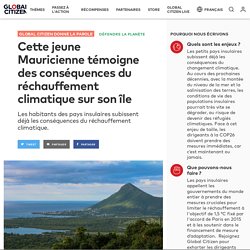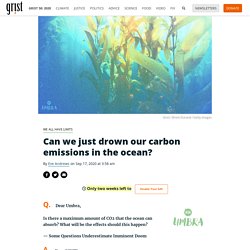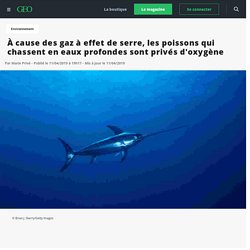

11 nov. 2021 Cette jeune Mauricienne témoigne des conséquences du réchauffement climatique sur son île. Les dirigeants mondiaux sont actuellement réunis à Glasgow pour la Conférence des Nations Unies sur le climat, la COP26, pour trouver des solutions afin de freiner le réchauffement climatique et garantir à tous un futur meilleur.

Hélas pour les pays insulaires, le futur, c’est maintenant. En effet, les populations insulaires subissent déjà les conséquences du réchauffement climatique, qu'il s'agisse de l’élévation du niveau de la mer, qui commence à faire disparaître les plages, ou de tempêtes tropicales de plus en plus dévastatrices. Envoyez votre vidéo : Pourquoi la crise climatique vous concerne-t-elle ? Des vagues de chaleur historiques aux inondations sans précédent, les effets du changement climatique nous touchent tous. Les dirigeants à la COP26 auront l'occasion de prendre des mesures pour défendre notre planète, et vous pouvez les y inciter En amont du sommet, nous exhortons les dirigeants mondiaux à agir - Téléchargez votre vidéo ! Astrid Young. 2 déc. 2020 Une centaine de chefs-d'oeuvre de la nature en danger à cause du changement climatique. L'Union internationale pour la conservation de la nature souligne dans son nouveau rapport que les trésors naturels de notre planète sont de plus en plus nombreux à être menacés par le réchauffement climatique.

De plus en plus de chefs-d'oeuvre de la nature sont en péril - à l'instar de la Grande Barrière de corail d'Australie - et c'est la faute du changement climatique, prévient mercredi l'Union internationale pour la conservation de la nature. Ce sont désormais un tiers des 252 sites naturels classés au patrimoine mondial par l'Unesco qui sont menacés par le changement climatique, qui détrône les espèces invasives et exogènes en tête des dangers encourus par ces espaces naturels d'exception, souligne dans son nouveau rapport, l'UICN, qui regroupe plus de 1.400 organisations et gouvernements. Can we just drown our carbon emissions in the ocean? By Eve Andrews on Sep 17, 2020 at 3:58 am.
Q.

Dear Umbra, Is there a maximum amount of CO2 that the ocean can absorb? What will be the effects should this happen? — Some Questions Underestimate Imminent Doom A. I’m not a fish. Why should coral reefs matter to me? By Eve Andrews on Jul 30, 2020. Q.

Dear Umbra, Aside from scuba-diving boredom, what will a world without coral reefs look like and how will it affect my day-to-day life? — Does Indifference Void Environmental Responsibility? A. Dear DIVER, Le Pacifique : un océan de solutions Polynésie : sauvons les perles ! Le 18 juillet 2020. Les coraux confrontés à « un niveau de menace significatif » dans les îles françaises de l’océan Indien. Les coraux sont confrontés à « un niveau de menace significatif » dans les îles françaises de l’océan Indien : 15 % de ces espèces sont en danger à La Réunion, 12 % à Mayotte et 6 % dans les îles Éparses, affirme le comité français de l’Union internationale pour la conservation de la nature (UICN). « Le réchauffement climatique figure au rang des principales menaces », explique-t-il dans un état des lieux inédit paru ce jeudi et mené conjointement avec l’Office français de la biodiversité (OFB) et le Muséum national d’Histoire naturelle (MNHN).

Il se traduit par « une augmentation de la température de l’eau de mer de surface, entraînant en saison chaude un blanchissement corallien » pouvant conduire « à la mort des coraux lorsque le phénomène est intense et se prolonge trop longtemps », précise-t-il. Australie : La Grande Barrière de corail a vécu son pire épisode de blanchissement. Avec l’été austral qui vient de s’achever, la Grande Barrière de corail a vécu son plus grave épisode de blanchissement de coraux, ont annoncé des chercheurs australiens, ce mardi, estimant que le réchauffement climatique menaçait la survie même de ce joyau australien classé au Patrimoine mondial.

Après une vaste étude le mois dernier, le professeur Terry Hughes, de l’Université James Cook, (Australie), a annoncé que la Grande Barrière de corail, qui s’étend sur 2.300 km, avait connu un nouvel épisode de blanchissement, le troisième en cinq ans, en raison de températures de l’eau records. Des « phénomènes graves »
Australie : La Grande Barrière est gravement touchée par le blanchissement de ses coraux. La Grande barrière a subi ces derniers mois des dégâts « très étendus », notamment dans des zones précédemment épargnées devenues le théâtre d’un « blanchissement modéré ou grave » des coraux, a annoncé ce jeudi l’Autorité du parc marin de la Grande barrière de corail, qui réalise une étude de la zone par reconnaissance aérienne.

Inscrit au Patrimoine mondial par l' Unesco en 1981, ce massif s’étend sur environ 2.300 kilomètres le long de la côte nord-est de l’Australie et constitue le plus vaste ensemble corallien de la planète. Replay 13h15, le dimanche... - Planète Fragile : récif en danger. To save our oceans, we have to change what we do on land. For decades, oceans have served as the planet’s carbon garbage dump, soaking up 90 percent of the excess atmospheric heat generated since 1970 and a third of our greenhouse gas emissions.

Now the 71 percent of the Earth that makes life on land possible has reached a frightening tipping point that threatens human existence, according to a landmark report issued Wednesday by the United Nations-supported Intergovernmental Panel on Climate Change, or IPCC. The findings suggest severe consequences for both humanity and nature, according to Ko Barrett, the panel’s vice chair, who spoke at a press briefing on Tuesday.
“This report highlights the urgency of timely, ambitious, coordinated and enduring action,” said Barrett, who is also the deputy assistant administrator of oceanic and atmospheric research at the U.S. National Oceanic and Atmospheric Administration. Scientists create a new guide for saving corals in a warming world. À cause du manque d'oxygène dans les océans, les invertébrés marins deviennent aveugles. La désoxygénation des océans liée aux émissions de gaz à effet de serre a des conséquences (tristement) inattendues : des chercheurs ont découvert qu’un faible taux d’oxygène dans la mer entraîne une cécité temporaire chez certains invertébrés marins.

La diminution du taux d’oxygène dans les océans n’aurait pas pour seule conséquence d’empêcher la faune marine de respirer… Elle l’empêcherait également de voir. Des chercheurs de l’institut océanographique Scripps de San Diego, aux Etats-Unis, ont publié une étude* dont les résultats indiquent que de faibles niveaux d'oxygène dans l'eau de mer pourraient aveugler certains invertébrés marins (mollusques et crustacés).
À cause des gaz à effet de serre, les poissons qui chassent en eaux profondes sont privés d'oxygène. Dernièrement, certaines espèces de poissons qui chassent habituellement en eaux profondes, comme le thon ou l’espadon, ont été aperçues à la surface des océans.

La faute aux gaz à effet de serre qui éliminent progressivement l’oxygène dans les profondeurs. Our-oceans-are-gasping-for-breath-and-we-ignore-it-at-our-peril. DO Oxygen Solubility Table. West Coast shores are bathed in ocean acidification “hot spots” Hot spots of ocean acidification have been found in the waters that wash onto the shores of the West Coast, a major concern for the region’s billion-dollar fishing industry as well as the region’s potentially fragile coastal ecosystems.
A new study of a 600-mile span of coastline found some of the lowest pH levels ever measured on the ocean surface, showing that significant acidification can be found in waters right along the shore. “Ocean acidification has made landfall” across the entire area, coauthor Francis Chan, an Oregon State University marine ecologist, said. As atmospheric carbon dioxide levels have risen (in red), the ocean has absorbed some of that CO2 (in green), lowering its pH (in blue). NOAA.
World's oceans facing biggest coral die-off in history, scientists warn. Scientists have confirmed the third-ever global bleaching of coral reefs is under way and warned it could see the biggest coral die-off in history. Since 2014, a massive underwater heatwave, driven by climate change, has caused corals to lose their brilliance and die in every ocean. The Great Barrier Reef has been brutally bleached for the second year in a row. Contrary to what you may have heard, the reef isn’t dead — not yet. But aerial surveys show that 900 miles of the 1,400-mile-long reef have been severely bleached in the past two years. Bleaching occurs when warm water causes stressed-out corals to expel symbiotic algae from their tissues; corals then lose their color and their chief source of food, making them more likely to die. Think you’ve had it rough this past year? You should hear what the Great Barrier Reef is dealing with. According to the cover article in today’s issue of the journal Nature, the iconic reef off the coast of Australia suffered unprecedented coral die-off after last year’s record-breaking bleaching event.
Now, as the Southern Hemisphere hits late summer temperatures, central and southern sections of the reef — areas which avoided the worst of last year’s bleaching — are in trouble. “We didn’t expect to see this level of destruction to the Great Barrier Reef for another 30 years,” coral researcher Terry Hughes told the New York Times. Hughes led the team that conducted aerial surveys to document the bleaching last year, as well as subsequent surveys to assess just how much of that bleaching turned into dying. Bleached corals don’t always turn into dead corals — some are able to recover when temperatures drop.
Er, if temperatures drop. Oceans are about to turn into a frothing cauldron of death. Mustafa Ali helped to start the EPA’s environmental justice office and its environmental equity office in the 1990s. For nearly 25 years, he advocated for poor and minority neighborhoods stricken by pollution. As a senior adviser and assistant associate administrator, Ali served under both Democratic and Republican presidents — but not under President Donald Trump. Acidification des océans : cartographie d'un phénomène 10 fois plus rapide qu'il y a 56 millions d'années. 18 510 lectures / 16 commentaires18 novembre 2014 ; révision : 16 juin 2015, 13 h 51 Alors que les émissions de CO2 dans l'atmosphère ne cessent de croître, réchauffant de plus en plus notre planète, elles contribuent également à l'acidification des océans dont les niveaux, de plus en plus inquiétants, viennent d'être cartographiés dans les différents mers et océans du globe.
L'acidification des océans est une conséquence directe de l'augmentation des concentrations en dioxyde de carbone (CO2) dans l'atmosphère, émises par nos activités aussi polluantes que, la plupart du temps, inutiles. Dungeness crabs threatened by, you guessed it, climate change. When it comes to American culinary institutions, the Dungeness crabs that are hauled ashore from California to Washington state every winter season are the crustacean equivalents of apple pie. The bountiful crab meat is a holiday staple in the San Francisco Bay Area and beyond.
When crabbing was suspended in the fall by an algae outbreak, journalists flocked to docks to produce lead news stories — just as they did when crabbing was restricted following a 2007 oil spill. Research published this month could give a crab connoisseur a case of acid reflux. Scientists reported in the journal Marine Biology that ocean acidification, which is caused when carbon dioxide pollution dissolves into oceans, can kill and stunt young crabs, potentially jeopardizing whole populations.
Page 7 of The Point of No Return: Climate Change Nightmares Are Already Here. Will EPA Heed the Pope's Call to Save Our Oceans? When it comes to saving our oceans, I'm wondering: What would Pope Francis do? With his sprawling encyclical on the fate of our planet this month, the pope became an unexpected revolutionary. I never thought I'd see bold environmental leadership arise from this powerful, historically conservative institution.
By now, everyone knows about his call to fight climate change, ocean acidification, pollution and loss of the planet's biodiversity. Pope Francis opened a unique opportunity for a renewed environmental movement with his landmark encyclical Laudato Si, or "On Care for our Common Home. " J-P Gattuso : "L'acidité de l'océan pourrait tripler d'ici 2100" Watch us explain ocean acidification with a soda maker. Now we can watch the oceans acidify in real time. How will ocean acidification impact marine life?
Many marine organisms—such as coral, clams, mussels, sea urchins, barnacles, and certain microscopic plankton—rely on equilibrated chemical conditions and pH levels in the ocean to build their calcium-based shells and other structures. A new analysis published in the journal Environmental Science and Technology provides a holistic analysis of how species will be affected worldwide under different climate scenarios. "Calcifying species are indispensable for ecosystems worldwide: they provide nursery habitats for fish, food for marine predators, and natural defenses for storms and erosion. Get ready for endlessly gross shrimp, thanks to climate change. Hard out here for a shrimp You may not think you care much about the mental well-being of imperiled sea spawn, but did ya know that a stressed-out shrimp does not a delicious cocktail make? Ocean Roundup: Map Reveals Ocean Acidification Hotspots, Illegal Sea Urchin Harvesting Causing Alarm in St. Lucia, and More.
Ocean acidification slurps up oysters. Editor’s note: We’re publishing a series from The Story Group that shows Americans on the front lines of climate change. The videos put faces to the warnings in the latest National Climate Assessment. “The ocean is so acidic that it is dissolving the shells of our baby oysters,” says Diani Taylor of Taylor Shellfish Farms in Shelton, Wash. She and her cousin Brittany are fifth-generation oyster farmers, and are grappling with ocean waters that are more acidic and corrosive than their fathers, grandfathers, and great-grandfathers knew. Arctic Species at Risk from Increasing Ocean Acidity from Rising Carbon Dioxide. First Posted: Dec 03, 2013 08:41 AM EST Cyclones can whip up water and wind, creating conditions that can impact local climate and conditions.
Now, scientists have discovered that far more of these wind storms spin across the Arctic than previously thought. It turns out that 1,900 churned across the top of the world from 2000 to 2010, leaving warm water and air in their wakes and melting sea ice in the Arctic Ocean. (Photo : Reuters) As carbon dioxide levels continue to rise, our oceans are facing a major threat. Like Us on Facebook. Ocean acidification could be creating friendless fish. Fish seem like chummy enough creatures, often schooling with fish they’re familiar with to avoid predators and increase the chances of finding a mate. But as carbon dioxide levels rise worldwide, they could lose their ability to recognize each other, in effect becoming “friendless” wanderers who will hang out with just about anybody. Quand les océans deviennent acides. How can we deal with ocean acidification? Step one: Study it.
Don’t you love soda makers? You push a bottle of plain ol’ tap water up to a nozzle that spurts CO2 into your water, making it bubbly and delicious. Now picture that happening to the oceans, all day, every day, and the result is distinctly less effervescent: Dissolved CO2 turns into carbonic acid turns into dissolving shellfish, stressed-out fish, fewer clouds, plummeting biodiversity, collapsed ecosystems, total annihilation. Dans un nouveau rapport, l'UNESCO prévient que l'acidification des océans s'effectue à un rythme sans précédent. 'Super corals' offer hope as oceans turn acidic. » 1356 Climat (21) : Conséquences (3) – Les Océans. What is Ocean Acidification? What is ocean acidification? Un Equilibre chimique menacé ou l'acidification des océans. Changes in Sea Saltiness Show We’re Affecting the Climate.
Endangered Oceans. Les océans n'ont jamais été aussi acides. Health of oceans 'declining fast' Fabien Cousteau pulls a Spongebob to live at the bottom of the sea for a month.